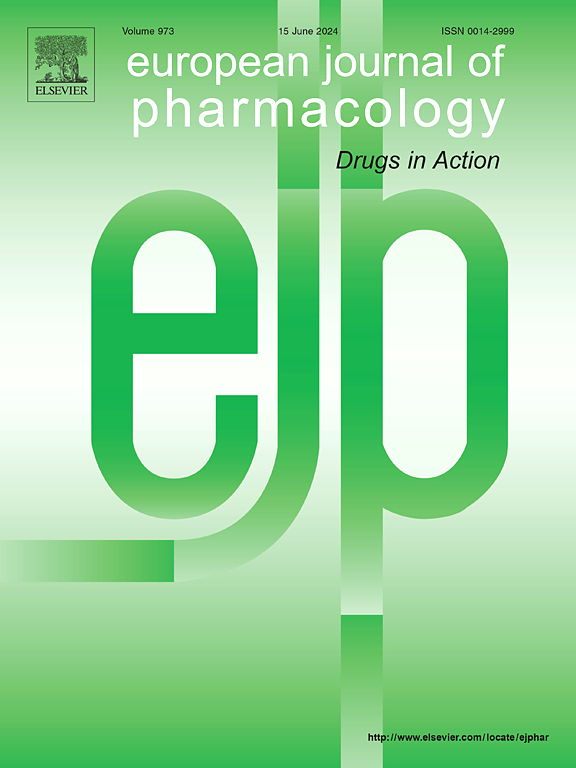LRP1在帕金森病和阿尔茨海默病的十字路口:α-突触核蛋白和淀粉样蛋白病理中的不同作用
IF 4.7
3区 医学
Q1 PHARMACOLOGY & PHARMACY
引用次数: 0
摘要
帕金森病(PD)是第二常见的神经退行性疾病,代表了老年人最常见的运动障碍。PD的神经病理是由于突变α突触核蛋白(α-Syn)在黑质致密部(SNpc)多巴胺能神经元(DNs)中的进行性沉积。此外,淀粉样蛋白(Aβ)和tau蛋白是阿尔茨海默病(AD)的标志,也参与PD和PD相关痴呆的发展。值得注意的是,α-Syn、a β、tau蛋白和神经元胆固醇代谢受低密度脂蛋白受体相关蛋白1 (LRP1)的跨膜蛋白调控,该蛋白在SNpc中高表达,并介导α-Syn在脑内的传递和播散。据报道,LRP1基因的缺失可以防止PD的发生和发展。然而,LRP1通过改善a β在血脑屏障(BBB)的清除和促进tau蛋白的蛋白水解,对AD神经病理具有神经保护作用。然而,LRP1在PD神经病理中的确切作用,主要是α-Syn,尚未完全解释。因此,本文旨在讨论和解释LRP1在PD中的作用,以及靶向LRP1神经元如何有助于PD的治疗。本文通过检索Scopus、Web of Science等在线数据库,检测LRP1的表达与PD发病机制之间的关系。本文章由计算机程序翻译,如有差异,请以英文原文为准。

LRP1 at the crossroads of Parkinson's and Alzheimer's: Divergent roles in α-synuclein and amyloid pathology
Parkinson's disease (PD) is the second most common neurodegenerative disease that represents the commonest movement disorder in the elderly population. PD neuropathology is due to the progressive deposition of mutant alpha synuclein (α-Syn) in the dopaminergic neurons (DNs) of the substantia nigra pars compacta (SNpc). Additionally, amyloid protein (Aβ) and tau protein, which are the hallmarks of Alzheimer's disease (AD), are also involved in PD and the development of PD-related dementia. Notably, α-Syn, Aβ, tau protein, and neuronal cholesterol metabolism are regulated by a transmembrane protein, low-density lipoprotein receptor-related protein 1 (LRP1), which is highly expressed in the SNpc and mediates the transmission and seeding of α-Syn in the brain. It has been reported that deletion of the LRP1 gene protects against the development and progression of PD. However, LRP1 has a neuroprotective effect against AD neuropathology by improving Aβ clearance across the blood-brain barrier (BBB) and enhancing tau protein proteolysis. Nevertheless, the exact role of LRP1 in PD neuropathology, mostly about α-Syn, is not completely explained. Therefore, this review aims to discuss and explain the role of LRP1 in PD and how targeting neuronal LRP1 may be helpful in the management of PD. In this review, online databases were involved by searching Scopus, Web of Science, and other search engine to detect the relationship between the expression of LRP1 and the pathogenesis of PD.
求助全文
通过发布文献求助,成功后即可免费获取论文全文。
去求助
来源期刊
CiteScore
9.00
自引率
0.00%
发文量
572
审稿时长
34 days
期刊介绍:
The European Journal of Pharmacology publishes research papers covering all aspects of experimental pharmacology with focus on the mechanism of action of structurally identified compounds affecting biological systems.
The scope includes:
Behavioural pharmacology
Neuropharmacology and analgesia
Cardiovascular pharmacology
Pulmonary, gastrointestinal and urogenital pharmacology
Endocrine pharmacology
Immunopharmacology and inflammation
Molecular and cellular pharmacology
Regenerative pharmacology
Biologicals and biotherapeutics
Translational pharmacology
Nutriceutical pharmacology.

 求助内容:
求助内容: 应助结果提醒方式:
应助结果提醒方式:


